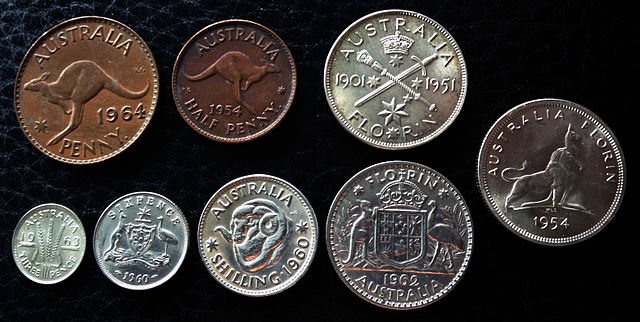50 Years of the Australian Dollar
14 February, 2016
Celebrating 50 years of the Australian Dollar by writing about it at some length.
Background
The Commonwealth Government introduced the first Australian currency in 1910, replacing British coinage, Sovereign and Half-Sovereign coins and banknotes issued by private banks and the colonies of Queensland and New South Wales. The new Australian Pound’s value was kept equal with the British Pound, because Empire.
Growing up, I thought that we had just switched from pounds and pence (perhaps with some ridiculous non-decimal amount of cents) to dollars and cents, but in fact the old currency was insane… I guess that’s what you get for copying the monetary system of a thousand-year-old empire. Here are four different ways of writing an amount of money.
- 32s 6d
- 32/6
- £1 12s 6d
- £1/12/6
When Britain decimalised the Pound Sterling in 1971, all of these values were replaced with £1.621⁄2. Madness.
12 pennies made a shilling, and there were 12 shillings to the pound. Guineas, which were used for almost-arbitrary[1] purposes, were worth 21 shillings, making them the baker's dozen version of the Pound. Although Guinea coins hadn't been used since the early 1800s, they persisted in name until decimalisation.
| Penny | Shilling | Pound |
|---|---|---|
| 1 | 0 | 0 |
| 12 | 1 | 0 |
| 240 | 20 | 1 |
These coins and banknotes were created in Australia, although there were banknotes printed by the Empire of Japan during World War II — these were used during the Japanese occupation of the Australian Territories of Papua and New Guinea.

[Coins of the Australian Pound](https://commons.wikimedia.org/wiki/File:Early_Imperial_Australian_Coins.jpg) by Designguy84 on Wikimedia Commons. Licensed under [CC-BY-SA 3.0](http://creativecommons.org/licenses/by-sa/3.0)
Even now, all Australian coins and banknotes (aside from the Holey Dollar) remain legal tender and could be deposited into your bank account, or walked into the Reserve Bank’s Sydney and Canberra branches.
Decimalisation
The Commonwealth Government appointed a Decimal Currency Committee in 1959, and it took less than a year for the committee to report back that yes, decimal currency was a good idea. It also made a number of recommendations about how the government should go about the changeover. The government approved the change during 1961 and two years later announced that the “C-Day” would take place in February 1966 — they also announced that Australia would use a system based on 10 shillings, with a minor unit valued at one one-hundredth of the major unit. According to wikipedia that’s because the Commonwealth Government wanted to have the new currency valued more than the US Dollar — but there’s a big ol’ “Citation Needed” on that.
The exact timing of the changeover would be determined by the opening of the new Royal Australian Mint in Canberra, which would soon replace the Melbourne and Perth branches of the Royal Mint in producing coins for use in Australia.
You may have heard that the original name for the “major unit” was the Royal, but Menzies wanted to maintain the customary names for the the other coins in the collection as well. So we missed a second bullet there when a massive backlash by the general public forced him to change the new name to the Dollar.
Our current coin sizes are based on the old ones. 5c coins are the same as the old sixpence, 10c is shilling-sized, (hold on to your hats here) 20c is the same as the two shilling coin, and the original round 50c was the same as a crown. These coins are the same size because that’s what they valued.
No account of Australian Decimalisation would be complete without watching Dollar Bill sing and dance his way into explaining the new currency system.
Today
Today, the Australian Dollar is used across Australia and all its territories, as well as Kiribati, Nauru, and Tuvalu.
In Tuvalu and Kiribati, Australian coins and banknotes are used alongside coins denominated in local Dollars. Both currencies are pegged at 1:1 with the Australian Dollar and as such they are considered Australian Dollars under ISO 4217.
One dollar coins replaced the original banknote in 1984, and the two dollar banknote was replaced in 1988.
The major change to Australian currency was in 1988 when the original paper notes were replaced with the world’s first polymer banknotes. Australian banknotes are printed by Note Printing Australia, a company owned by the Reserve Bank which prints polymer banknotes for most countries which use them.
The banknotes were steadily redesigned throughout the early to mid 90s and the current designs (with minor alterations) are set to be used into the indefinite future.
[1] Most commonly professional fees, art, horses, land and luxury items.
Share